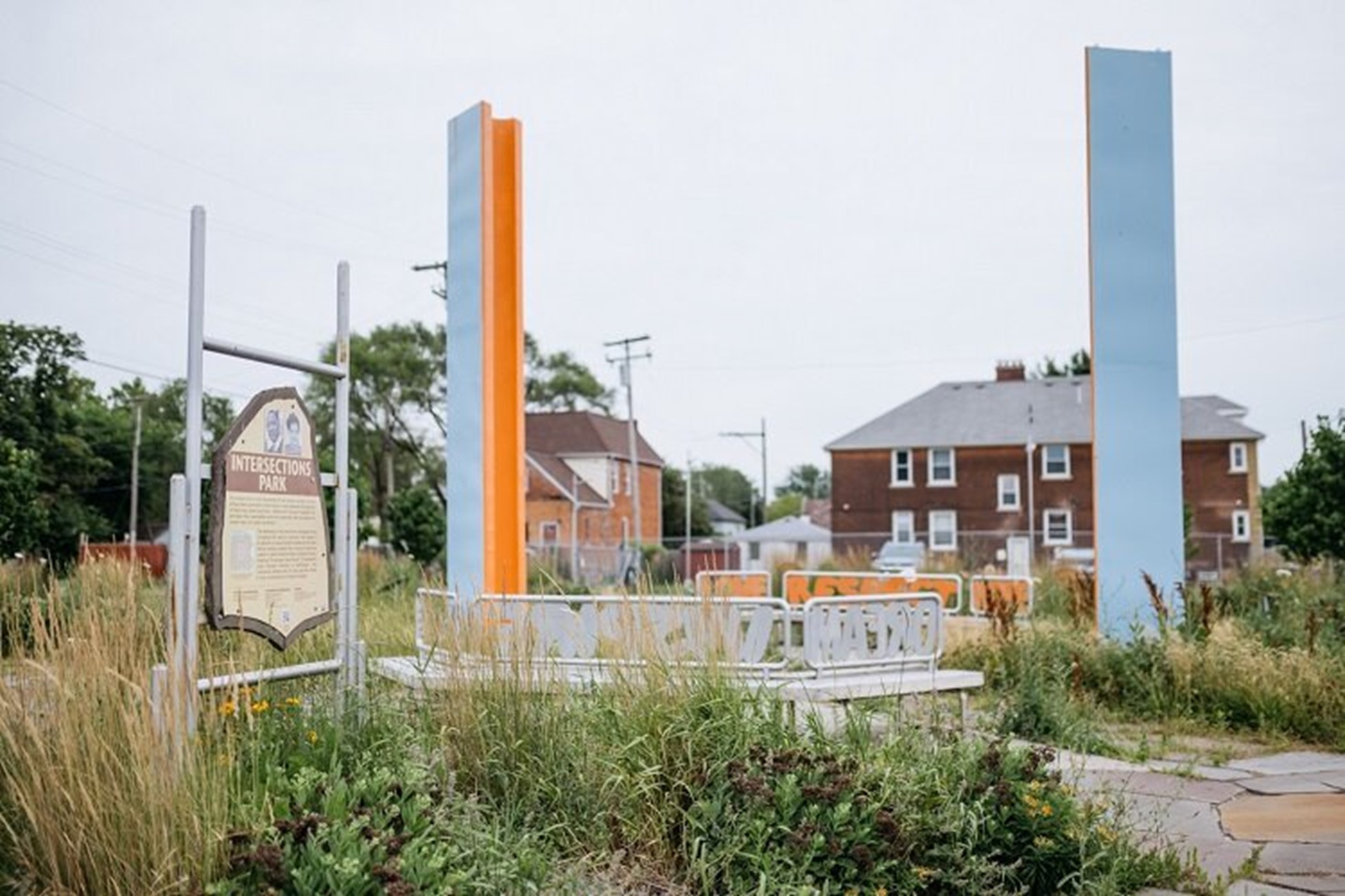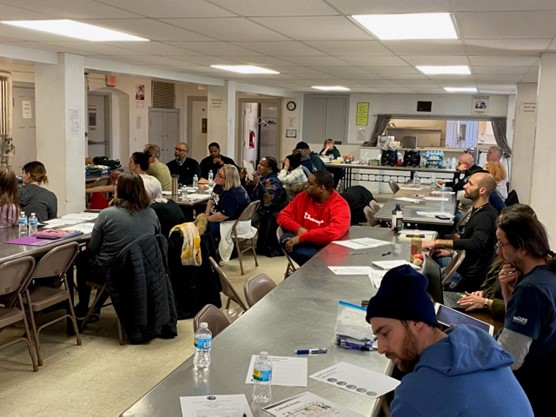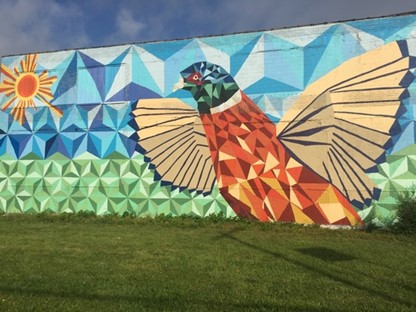North Corktown Creative Placekeeping


The Action
Heritage Works, a nonprofit that promotes youth and community development through cultural traditions, arts, and education, was approached to co-lead the development of a vacant lot in the North Corktown (NoCo) neighborhood of Detroit, Michigan. Arts-based engagement with youth, residents, and the neighborhood association transformed the land into a reflective pocket park that enshrines the NoCo community’s values. Intersections Park, as it is known, is at the crossroads of Rosa Parks and Martin Luther King, Jr. boulevards and features two sculptures commemorating the civil rights leaders.

According to Heritage Works, the park “resulted in increased social cohesion and a desire to continue transforming [the] community” through creative “placekeeping” efforts such as resident-driven urban design standards and a NoCo cultural plan.
Democracy Challenge
The US Department of Arts and Culture, which describes itself as a “grassroots action network”, defines “placemaking” as the “process of community development that leverages outside public, private, and nonprofit funding to strategically shape and change the physical and social character of a neighborhood using arts and cultural activities.” Alternatively, “placekeeping” as the “active care and maintenance of a place and its social fabric by the people who live and work there. It is not just preserving buildings but keeping the cultural memories associated with a locale alive, while supporting the ability of local people to maintain their way of life as they choose.” In other words, to prevent sliding from placemaking into displacement and gentrification, revitalization projects should aim for placekeeping, which entails engaging the community, centering development around existing residents' needs, and preserving historical and cultural identities.
Research shows that civic engagement and participation in cultural activities are associated with higher levels of well-being. Heritage Works’ NoCo placekeeping strategy combines both elements. In partnership with the city of Detroit and the North Corktown Neighborhood Association, the strategy’s goals are to preserve unique spaces and places, and to connect new development with the existing and ancestral community. This approach engages NoCo residents, fostering a sense of belonging and sustained community participation by building on the neighborhood’s ecological, cultural, and historical roots.
How It Works and How They Did It
When conversations about installing a sculpture at the intersection of Martin Luther King, Jr. and Rosa Parks boulevards arose, Heritage Works Executive Director Rhonda Greene knew she had to get involved. At the time, NoCo was debating the installation of a sculpture of the sci-fi character RoboCop. Many stakeholders felt the installation would be disconnected from the rich history and culture of Detroit’s oldest neighborhood. One resident, after raising concerns about the artwork, invited Greene to participate in a community conversation during which she learned about the plans to develop Intersections Park. Heritage Works was ultimately asked to be the neighborhood’s nonprofit partner on this project. Greene––drawing from her experience with the installation of Gateway to Freedom, a monument along the Detroit River memorializing the city’s role in the Underground Railroad––was eager to support this additional opportunity for storytelling.
Intersections Park opened in 2016 through the combined efforts of residents, students, and Heritage Works. The park, designed by NoCo resident Jeffrey Klein and co-created with students at Detroit’s Burton International Academy, includes two sculptures, public art benches, and interactive elements such as goblet drums. The park also features a pathway of stone pavers that create the Adinkra symbol for Siamese crocodiles. This symbol represents the park’s overarching themes of democracy and unity: although the crocodiles share one stomach, they fight over food, a reminder that infighting and tribalism are harmful to all who engage in it.

Unbeknownst to Heritage Works, Intersections Park would lead to further placekeeping initiatives in the neighborhood. Because North Corktown was identified as one of five Detroit neighborhoods for revitalization, the community wanted to put forth their own priorities and aspirations for NoCo. Residents developed their own sense of place guidelines and urban design standards and guidelines for redevelopment, which were informed by a series of community meetings and reflect the values and priorities of North Corktown residents. Through convenings, canvassing, and organizing, the community’s Steering Committee also created a cultural plan that, based on placekeeping, prioritizes community input and sustainable cultural projects. This four-month effort was informed by prior neighborhood planning documents and developed through input from two public meetings, community surveys, a feasibility study, and funding potential. The resulting resident-developed cultural priorities include a culturally-relevant community center, murals and street art, green spaces and recreation, and programs and festivals. The plan also cites the leading and supporting authorities and groups, such as the city, the neighborhood association, local business owners, property owners, and residents, to implement the projects.
A common thread amongst all of the projects/initiatives is the strong desire to preserve and celebrate the culture of the North Corktown community
How’s It Going?
People walk and ride bikes through Intersections Park daily, often taking time to sit on the benches or read poetry written by Burton International Academy students displayed in the park. Since the park’s opening, Heritage Works has begun investigating ways to activate spaces between Intersections Park and nearby Nagel Park. The nonprofit is also building capacity to maintain public art projects throughout NoCo. As Greene notes, the upkeep of cultural amenities is an important part of placekeeping.

Pending final approval from the US Department of Housing and Urban Development’s City’s Choice Neighborhoods Critical Community Improvements program, NoCo will be home to a new Community Empowerment Center, a multipurpose facility providing residents with vital services such as childcare, youth programs, community space, and economic and workforce development opportunities. The center will also have room for Heritage Works, the North Corktown Neighborhood Association, and a “resilience space” to support the community in times of natural disaster or other crises. The city hopes to break ground on the project in 2024 and expect construction will take two years.
Considerations
The city of Detroit benefitted from two US federal programs to further NoCo’s redevelopment:
- Choice Neighborhood Designation: Residents of NoCo, which the city of Detroit designated as a “Choice Neighborhood”, had a vested interest in ensuring the inevitable development of their community reflected their values and priorities. The designation unleashes funding for community projects such as the construction of the Empowerment Center.
- OUR TOWN Grant from the National Endowment for the Arts: Heritage Works was awarded the OUR TOWN grant to support efforts in creative placemaking. These funds, accompanied by technical assistance, will support community planning and design of the Empowerment Center while helping to mitigate cultural displacement.
Point of Contact
Rhonda Greene
Executive Director
Heritage Works
+1 313-496-4000
[email protected]
Who Else Is Trying This?
- Oakland, California, US: Oakland’s Paint the Town program invites residents to co-create murals with friends, neighbors, or community organizations. A partnership among the Oakland Department of Transportation, Eastside Arts Alliance, and Safe Passages, an organization that combats poverty, Paint the Town was started after survey results revealed that Oakland residents wanted to use city resources to turn streets and crosswalks into works of art. Paint the Town aims to empower neighborhoods and foster community ownership, especially in under-resourced areas.
- Ajo, Arizona, US: The International Sonoran Desert Alliance (ISDA) has focused for 15 years on the creative reuse and revitalization of Ajo’s historic town center. ISDA’s projects, with the support of artists and culture bearers, aim to strike a balance between the historical identity of a structure and its new use. ISDA believes honoring the past while adapting to the future is at the core of creative and successful placekeeping.
- Newark, New Jersey, US: Newark Creates is a collaborative initiative that brings together community members and nonprofit, for-profit, and government stakeholders to advance communities through arts and culture. It supports Newark’s civic, social, and economic growth and promotes the creation, production, and availability of art and culture in the city.
- Barcelona, Spain: Out of the Darkness focuses on the Catalonian city of Barcelona, and the dramatic transformation of public spaces that are deeply connected to the past yet are now exemplars of democratic engagement in Spain. From the notorious prison known as La Model to a dog racing track turned civic tech hub, Out of the Darkness takes viewers to the sites where dramatic change begins and talks to the citizens who are at the heart of democratic resilience in Barcelona.